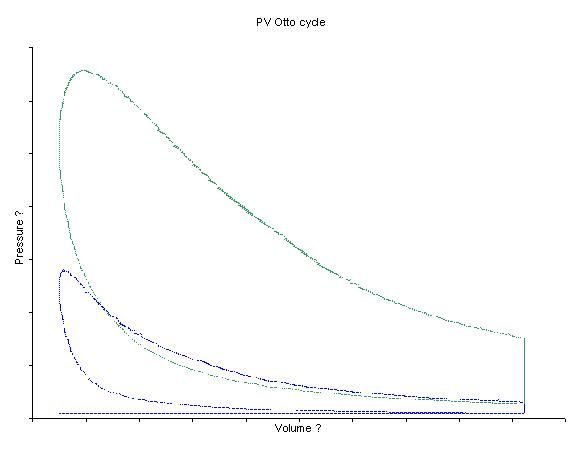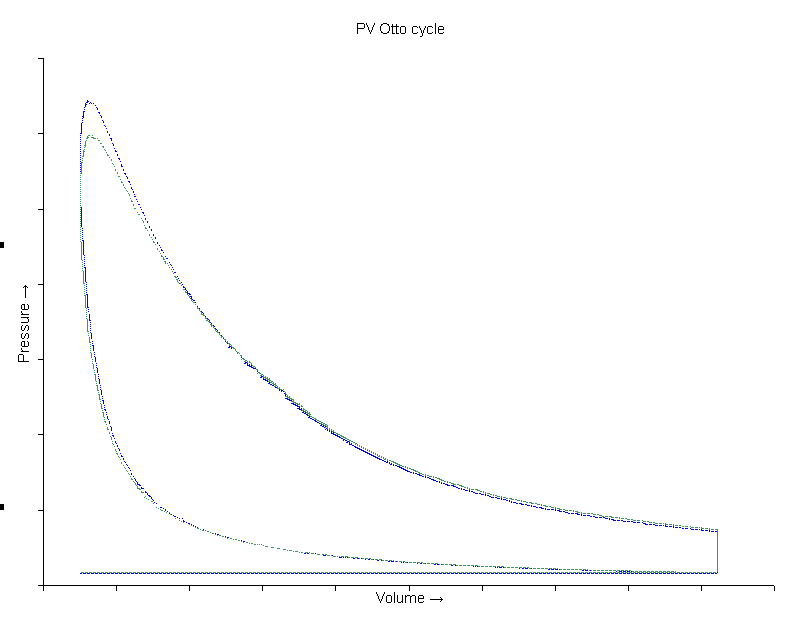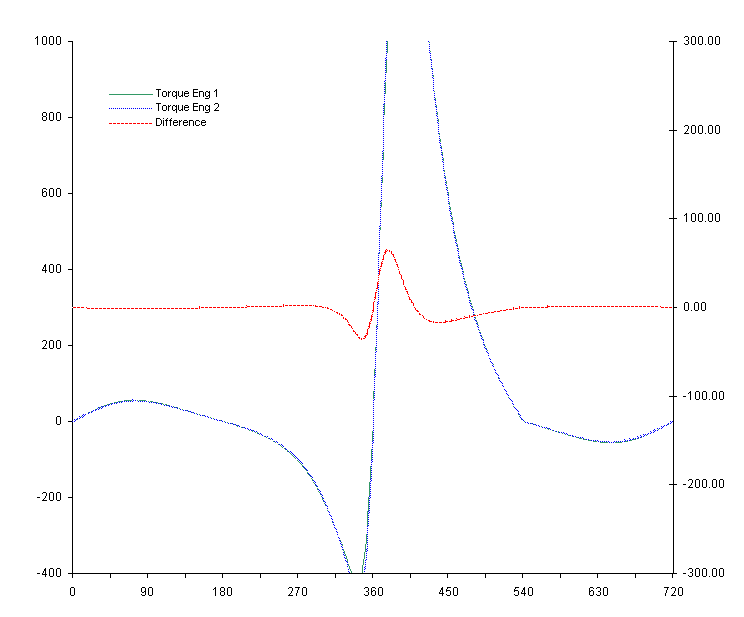You are using an out of date browser. It may not display this or other websites correctly.
You should upgrade or use an alternative browser.
You should upgrade or use an alternative browser.
High compression turbocharged engines.
- Thread starter Kozy
- Start date
1. No. The green line is the same in the first three, it changes in No.4.
2. Yes. The work done in one cycle varies from positive to negative, the average over the cycle is the torque output.
3. Correct.
1. What does the green line in No. 4. represent then?
And for the discussion:
a. why do you thing that No. 3. wouldn't work that well. I'm just asking because I don't understand why.
b. What means retarding the ignition? And why does that affect peak pressure?
- Joined
- Aug 18, 2008
- Messages
- 4,081
1. What does the green line in No. 4. represent then?
No.4 is to show both engines at 200% VE (1 Bar of boost) but the blue line is with 11:1 compression and the green is 9:1. As you can see, the 9:1 engine can use more timing whilst keeping peak pressure reasonable, and makes more torque than the 11:1 engine.
a. why do you thing that No. 3. wouldn't work that well. I'm just asking because I don't understand why.
The ignition point is too late, meaning the peak pressure is created when the piston is already some way down the bore and the total pressure gain is reduced. You can see it in the graph as the dip just after peak pressure. This is because the fuel burn takes some time to get going.
b. What means retarding the ignition? And why does that affect peak pressure?
Related to the above, to retard the ignition is to move it closer to TDC, so 20° is retarded from 30° as it is 20° 'before top dead center', which is 10° later in the cycle than 30° BTDC.
The reasons it affects torque are complicated, but are related to how fast the fuel burns. Because the increase in pressure is not instant, the fuel needs to be ignited early so that peak pressure is achieved when there is enough leverage on the crank to produce torque. If there is no leverage, i.e. at TDC, then no matter how much cylinder pressure you have, there is no torque output. Maximum cylinder pressure and maximum torque arrive at different points, max pressure at around 10-15° ATDC and max torque around 30-35° ATDC.
If you leave ignition too late, cylinder pressure reduces as the volume increases and overall torque output drops.
Last edited:
- Joined
- Aug 18, 2008
- Messages
- 4,081
Kozy, quick question. Can you teach my thermodynamics class at uni? Those graphs have genuinely helped me understand my course. Haha.
Some way off that yet, still learning this stuff as I go!

No.4 is to show both engines at 200% VE (1 Bar of boost) but the blue line is with 11:1 compression and the green is 9:1. As you can see, the 9:1 engine can use more timing whilst keeping peak pressure reasonable, and makes more torque than the 11:1 engine.
The ignition point is too late, meaning the peak pressure is created when the piston is already some way down the bore and the total pressure gain is reduced. You can see it in the graph as the dip just after peak pressure. This is because the fuel burn takes some time to get going.
Related to the above, to retard the ignition is to move it closer to TDC, so 20° is retarded from 30° as it is 20° 'before top dead center', which is 10° later in the cycle than 30° BTDC.
The reasons it affects torque are complicated, but are related to how fast the fuel burns. Because the increase in pressure is not instant, the fuel needs to be ignited early so that peak pressure is achieved when there is enough leverage on the crank to produce torque. If there is no leverage, i.e. at TDC, then no matter how much cylinder pressure you have, there is no torque output. Maximum cylinder pressure and maximum torque arrive at different points, max pressure at around 10-15° ATDC and max torque around 30-35° ATDC.
If you leave ignition too late, cylinder pressure reduces as the volume increases and overall torque output drops.
P = paragraph(writing with my iPhone)
P 1.: that is called aggressive vs conservative tuning if I'm not wrong?
If that's true, why does timing changes the output so much? Still we will get more torque of the sylinder is able to handle the sylinder pressure? If so, does aftermarket sleeves handle more pressure then?
P 2.: that's make sense now
P 3 and 4.: I don't understand that, I think I have to do more reading before I'm able to understand that.
What would more fuel do?
Last edited:
- Joined
- Aug 18, 2008
- Messages
- 4,081
Conservative timing would be with quite low ignition advance figures, say 15-20°, this keeps the cylinder pressures low and the window for error is larger, for instance if you put some low grade fuel in, it'll still run OK.
Aggressive tuning would be running the advance as high as possible which makes great power but means that the window for error is very small. Low grade fuel could melt a piston with an agressive tune.
You can tune either way with low or high compression, but the windows move. Conservative on a low comp build might be aggressive on a high comp build for instance. Generally, an aggressive tune on a low comp build will make more power than a conservative hi comp tune, though there are always exceptions.
You can indeed make more torque if the cylinder can handle more pressure, but as the diagrams show, it's not all about peak pressure, it's about average pressure and a boosted engine makes more average pressure even with the same peak pressure as an NA engine. Aftermarket sleeves will allow you to maintain more peak, but there are plenty of other limiting factors too, the knock limit of the fuel, the strength of the conrods, pistons, head bolts etc. Any time you make one factor better, the next weak point is up to stop the fun!
Aggressive tuning would be running the advance as high as possible which makes great power but means that the window for error is very small. Low grade fuel could melt a piston with an agressive tune.
You can tune either way with low or high compression, but the windows move. Conservative on a low comp build might be aggressive on a high comp build for instance. Generally, an aggressive tune on a low comp build will make more power than a conservative hi comp tune, though there are always exceptions.
You can indeed make more torque if the cylinder can handle more pressure, but as the diagrams show, it's not all about peak pressure, it's about average pressure and a boosted engine makes more average pressure even with the same peak pressure as an NA engine. Aftermarket sleeves will allow you to maintain more peak, but there are plenty of other limiting factors too, the knock limit of the fuel, the strength of the conrods, pistons, head bolts etc. Any time you make one factor better, the next weak point is up to stop the fun!
Right lots of information now from reading all of this leaves me thinking
there must be a formula for optimum cr for a turbo build if you know what fuel and hp and boost pressure you've got to play with or at least some sort of way of idenifying what would work what wouldn't in a general formula
also doesn't the whole power curve have to be taken into account in this as part of the reason for higher cr turbo builds was to keep off boost good as well as fast spooling hope I've understood this right
there must be a formula for optimum cr for a turbo build if you know what fuel and hp and boost pressure you've got to play with or at least some sort of way of idenifying what would work what wouldn't in a general formula
also doesn't the whole power curve have to be taken into account in this as part of the reason for higher cr turbo builds was to keep off boost good as well as fast spooling hope I've understood this right
Last edited:
- Joined
- Aug 18, 2008
- Messages
- 4,081
There may well be a formula, but I've never seen it. Maybe I'll create it.
Doing what I have done here is good way of matching the two, but it is hideously long winded. It's not as simple as multiplying the boost by the CR to give some kind of 'effective' CR. It simply does not work like that. An 11:1 engine boosted to one bar is 'effectively' 21:1 CR, but the thermodynamic effects are not the same at all.
I'll put a version of the above on my website when I get round to making it. Just need a couple hundred quid spare to get the software compiler...
Doing what I have done here is good way of matching the two, but it is hideously long winded. It's not as simple as multiplying the boost by the CR to give some kind of 'effective' CR. It simply does not work like that. An 11:1 engine boosted to one bar is 'effectively' 21:1 CR, but the thermodynamic effects are not the same at all.
I'll put a version of the above on my website when I get round to making it. Just need a couple hundred quid spare to get the software compiler...
Does anyone have any number of how much peak pressure the stock and after market sleeves can handle?
I assume the average sylinder pressure is not depended on either boost or compression, but of other exampel head internalt, tuning etc. Or do I get it wrong?
I assume the average sylinder pressure is not depended on either boost or compression, but of other exampel head internalt, tuning etc. Or do I get it wrong?
- Joined
- Aug 18, 2008
- Messages
- 4,081
Peak pressure can be made with compression, boost or ignition timing, but average pressure is more a function of boost than anything else. Compression and ignition timing do have a small effect, but minimal compared to boost.
No idea on aftermarket sleeve limits I'm afraid, only an educated guess going on the sort of power that such builds can produce. I'd imagine 1200psi shouldn't be a problem, but I could be way out.
No idea on aftermarket sleeve limits I'm afraid, only an educated guess going on the sort of power that such builds can produce. I'd imagine 1200psi shouldn't be a problem, but I could be way out.
- Joined
- Aug 18, 2008
- Messages
- 4,081
Ball park, you're looking at 583lbft at 7200rpm to make 800bhp. At 70lbft/litre, you'd need an 8.3 litre engine to make that, so 8.3/1.8 is 4.63x the capacity of a B18. Each bar of boost is effectively an extra 1800cc capacity, so that suggests around 3.6bar of boost to make 800bhp.
Tapping it in, it takes more like 4bar and an 8:1 CR. Specific torque is only 65lbft/litre.

Peak pressure is 1915psi. Average is 643psi.
Tapping it in, it takes more like 4bar and an 8:1 CR. Specific torque is only 65lbft/litre.

Peak pressure is 1915psi. Average is 643psi.
Last edited:
- Joined
- Aug 18, 2008
- Messages
- 4,081
800bhp out of 1800cc?
I was basing my numbers on the breathing capabilities of a standard engine. At that level of build I guess we're not talking about throwing together mismatched parts.
Combined with the shetland ponies the 'muricans use to measure power, 700bhp is probably doable on about 2.2-2.5bar with a well sorted build, funky fuelling and high compression.
I was basing my numbers on the breathing capabilities of a standard engine. At that level of build I guess we're not talking about throwing together mismatched parts.
Combined with the shetland ponies the 'muricans use to measure power, 700bhp is probably doable on about 2.2-2.5bar with a well sorted build, funky fuelling and high compression.
Last edited:
- Joined
- Aug 18, 2008
- Messages
- 4,081
Not easily, it's basically a measure of efficiency, directly linked with BMEP. It's what you aim to increase when tuning NASP engines, and we all know how difficult that is.
You'll not find anything better than about 90lbft/litre even in F1, most high performance road engines will be between 70/80lbft/litre. It's physically limited by the amount of air and fuel you can get into the engine, unlike bhp/litre which can be increased with revs.
Obviously you can boost and get more, but you're forcing more charge in. Doing an effective displacement (Capacity x (boost +1)) check will reveal much the same limits as NA. If anyone says they are bettering 90lbft/litre they are being flamboyant with the truth.
You'll not find anything better than about 90lbft/litre even in F1, most high performance road engines will be between 70/80lbft/litre. It's physically limited by the amount of air and fuel you can get into the engine, unlike bhp/litre which can be increased with revs.
Obviously you can boost and get more, but you're forcing more charge in. Doing an effective displacement (Capacity x (boost +1)) check will reveal much the same limits as NA. If anyone says they are bettering 90lbft/litre they are being flamboyant with the truth.
Ok, I understand. Let see some realistic graph then.
Can you make graphs:
- 10 compression, 350 torque
- 9 compression, 350 torque
I'm after what the boost has to be and what peak and average pressure it would be to make that power.
This should give 400whp.
My first setup would be 11.1:1 and 0.5 bar boost. (JDM B18C with GT28RS) Can you get me graph on that?
Edit: You already have that on. Interesting.
Can you make graphs:
- 10 compression, 350 torque
- 9 compression, 350 torque
I'm after what the boost has to be and what peak and average pressure it would be to make that power.
This should give 400whp.
My first setup would be 11.1:1 and 0.5 bar boost. (JDM B18C with GT28RS) Can you get me graph on that?
Edit: You already have that on. Interesting.
Last edited:
rs250nut
Boosting since 1998
- Joined
- Feb 14, 2011
- Messages
- 598
I think you may struggle with the pressure side of things, pressure from what? 2 bar from a t28 is very different in terms of air flow to that of a t67. Not trying to be an ass just saying things as they are. This is where compressor maps would come in I suppose. And then how many pounds of air a given engine takes to make 1hp, there is a good article on this on the Garrett website some where, here ya to
http://www.turbobygarrett.com/turbobygarrett/sites/default/files/PDF/Turbo Tech 103.pdf
There are a few other bits of turbo tech in there that are well worth a read, I ended up with a diary full of math........
http://www.turbobygarrett.com/turbobygarrett/sites/default/files/PDF/Turbo Tech 103.pdf
There are a few other bits of turbo tech in there that are well worth a read, I ended up with a diary full of math........
Last edited:
- Joined
- Aug 18, 2008
- Messages
- 4,081
No, good points mate. I guess the flow rate could be linked to the VE parameter, high pressure and low flow will end up with a reduced cylinder pressure, is that what you are hinting at?
Compressor maps are certainly useful when it comes to designing the powerband you want to the pressure to be delivered in, however I am not really looking at that right now. I did a bit of those at uni, the first couple of pages all looks familiar, I will have a read through the rest when I've got some time.
Compressor maps are certainly useful when it comes to designing the powerband you want to the pressure to be delivered in, however I am not really looking at that right now. I did a bit of those at uni, the first couple of pages all looks familiar, I will have a read through the rest when I've got some time.
- Joined
- Aug 18, 2008
- Messages
- 4,081
Ok, I understand. Let see some realistic graph then.
Can you make graphs:
- 10 compression, 350 torque
- 9 compression, 350 torque
I'm after what the boost has to be and what peak and average pressure it would be to make that power.
Assuming both are at 45° MBT timing and all else is equal:


Blue - 10:1 is using 1.56bar. 1876psi peak, 456psi average
Green - 9:1 is using 1.65bar. 1741psi peak, 443psi average.
Not a lot in it.
Last edited:
